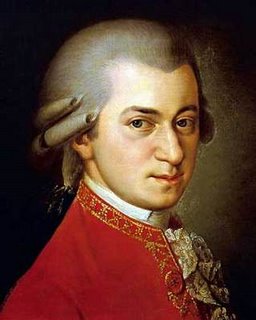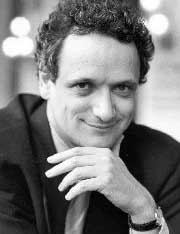Mostly Modest Mozart
 The three symphonies that conclude Mozart’s symphonic output also concluded the 40th anniversary Mostly Mozart season. Music Director Louis Langrée conducted the Mostly Mozart Festival Orchestra (in its midst a familiar face: BSO principal cellist Ilya Finkelshteyn moonlights with the MMFO) at Avery Fisher Hall in energetic, meaty performances.
The three symphonies that conclude Mozart’s symphonic output also concluded the 40th anniversary Mostly Mozart season. Music Director Louis Langrée conducted the Mostly Mozart Festival Orchestra (in its midst a familiar face: BSO principal cellist Ilya Finkelshteyn moonlights with the MMFO) at Avery Fisher Hall in energetic, meaty performances.
It was a conventional end to this double-anniversary summer (the Festival’s raison d’être’s 250th is still being celebrated, after all) and a far cry from the commissions, world premieres, “cutting-edge visual art installations,” or Pete Sellars’ Zaїde production it featured. Gidon Kremer, Joshua Bell, András Schiff, Concerto Köln, William Christie with Les Arts Florissants, the Tallis Scholars, and the Leipzig Quartet had all offered off-season diversion, allowing local critics without a ticket to Bayreuth, Lucerne, or Salzburg to avoid inactivity. Martin Bernheimer’s reviews for the FT often made for cruelly delightful summer reading.
Cruel delight might well have been Mozart’s state in composing these three last symphonies – all the fruit of one productive summer in 1788 in which Mozart saw himself faced with his share of personal and financial troubles. As usual with Mozart, his music tells nothing of his worries: he was equally capable of writing sun-flooded, congenial works in times of depression and melancholic tear-jerkers when high on life.
One of Mozart’s greatest gifts (and perhaps cause for some of the occasional derision hurled his way) is that his music is so darn beautiful that even the worst performance can still make for a pleasant experience. Maybe this quality also makes a superb performance harder to detect than would be the case with a more ‘difficult’ work. With the Beethoven Violin Concerto, for example, only a superb rendition assures that the listener is truly moved. Mozart moves always. Just consider the hum-along irresistibility of Symphony No. 40 – every part of it a ‘greatest hits’ moment, stuck in our heads since we were first exposed to classical music as kids. The difference between the invariably ‘pleasant’ and the truly elating experience of a Mozart performance might well be determined by the mood and expectation of the listener. On a rainy Tuesday I’ll like my Mozart brooding and ominous, on a sunny Thursday gay and light. Here with a sumptuous, big orchestra; there with “HIP” forces. Gliding along smoothly once; a spring in every step another time. Because Langrée’s Mozart seems a Mozart for all seasons, it likely disappointed no one. A median approach, aiming for moderation and beauty alone, may sink more finicky scores and composers, but with Mozart that’s no way to keep the cream from floating to the top. The wild enthusiasm of the crowd (‘deliberate’ or ‘indiscriminate’ does not apply here) proved that point.
The difference between the invariably ‘pleasant’ and the truly elating experience of a Mozart performance might well be determined by the mood and expectation of the listener. On a rainy Tuesday I’ll like my Mozart brooding and ominous, on a sunny Thursday gay and light. Here with a sumptuous, big orchestra; there with “HIP” forces. Gliding along smoothly once; a spring in every step another time. Because Langrée’s Mozart seems a Mozart for all seasons, it likely disappointed no one. A median approach, aiming for moderation and beauty alone, may sink more finicky scores and composers, but with Mozart that’s no way to keep the cream from floating to the top. The wild enthusiasm of the crowd (‘deliberate’ or ‘indiscriminate’ does not apply here) proved that point.
The blueprint and the rough blocks of music that alternative with filigrane interludes make the 41st Symphony (tellingly enough given the ponderously weighty nickname “Jupiter” and habitually described as “Olympian”) more inviting to the ‘full-body’ approach. A heavy hand is less exposed here. Bombast and thunder are arguably a part of the work. The superimposed drama for Mozart’s last sounds emitting from this year’s festival might have been calculated. The result often reminded of an old-fashioned Brandenburg Concerto performance.
Here as in the other two symphonies, the ensemble work might have been cleaner (every vigorously attacked note of the celli and basses was preceded by a buzzing “ssssssffft” before the actual note appeared; fast passages in the violins tended to be flabby before uniting more tightly again for less agitated notes), but delightful contributions from the wind section (exposed clarinet and flute parts especially) appeased successfully. But why were the most obvious aspects of interpretation cared for excessively? Diminuendos that can’t be missed anyway were elaborated on while simple dotted rhythms or syncopations in between were allowed to lumber about.
Lest one demand a performance that will be remembered even years from now, it is best to sit back and bask in the beauty that is Mozart, enjoy the amiably playing orchestra, and resist tapping along with your feet. If I don’t remember specifics of Saturday’s performance even at lunch tomorrow it might be a valuable lesson from Mozart: enjoy the moment, don’t take everything seriously and nothing too seriously. Mozart – not always but often – is a proto-idol of our modern ‘fun-culture’. Little wonder that he only appeals more and more to us, 250 years after he first saw the light of day.




















































